It's hard to escape the wave of the metaverse. While major companies are stepping up investment to gain a foothold in this new world, few people know what this virtual universe is like. What is it used for? What is its business model? Is it, as some predict, the future of the Internet or just another trendy marketing concept? Trainer and expert in artificial intelligence and robotics, Cédric Vasseur guides us through this new universe and explores its professional potential.
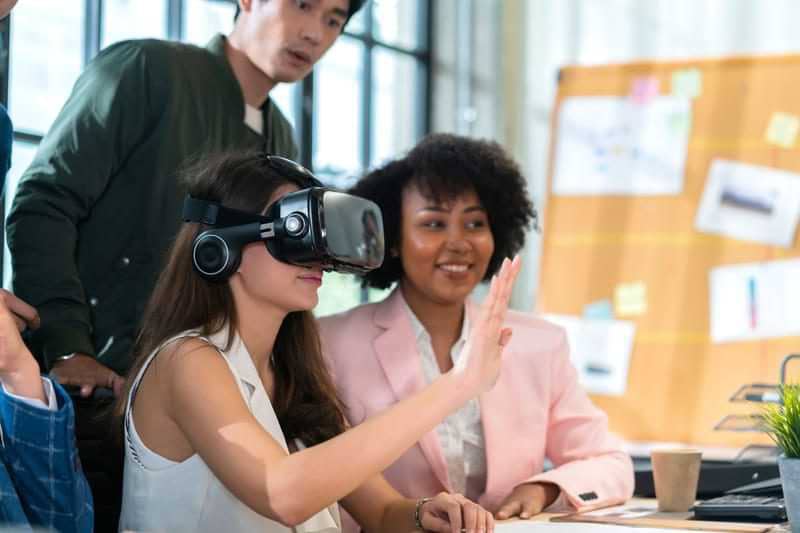
Carrefour is using it to conduct job interviews, KPMG to train its employees, Siemens is creating remotely controllable industrial robots, Warner Music is going to open a theme park there, luxury fashion brands (Gucci, Louis Vuitton...), as well as fast fashion brands such as Zara and H&M, are selling clothes there... The metaverse is teeming with projects. The proof is in the pudding: the metaverse is already attracting huge amounts of capital - $120 billion by 2022, according to McKinsey.
You have to go back to the Internet boom to see such a rapid rush into a new technological playground. Things have happened very quickly. It all began in October 2021. Mark Zuckerberg renamed his Facebook group Meta, emphasising that the metaverse was the future of the Internet.
From now on, the social networking giant, which includes Facebook, Instagram and WhatsApp, will devote a large part of its business and capital to building its own metaverse, Horizon Worlds.
The main proponent of the collaborative web, web 2.0, intends to propel his group to the forefront of web 3.0 (or Web3), a decentralised web using the technologies of the Internet. blockchain and NFTs. But what exactly is a metaverse? What's all the fuss about this word?
What is a metaverse?
Facebook may have popularised the term metaverse, but fans of science fiction and online video games have been familiar with it since the 1990s. The term first appeared in 1992, in the novel The Virtual Samurai by Neal Stephenson. Contraction of meta (beyond, in Greek) and universe, a metaverse designates a 3D virtual world accessible via a virtual reality headset and in which we are represented by an avatar.
But there are several definitions of a metaverse. Gartner's definition is the benchmark: a metaverse is a virtual universe that must have the following characteristics:
- persistent and immersive;
- collective and shared ;
- created thanks to a digital reality and enhanced physics ;
- accessible via any connected device (smartphones, PCs, VR headsets, tablets, etc.);
- powered by a blockchain-based currency.
Immersivebecause most people access this 3D universe via the bias virtual reality (VR) headsets.
Persistent, because, as with any persistent world, it doesn't cease to exist when you disconnect. In your absence, other people continue to evolve and change it. The next time you log on, your avatar will be back in the same state, but the world will have evolved. Persistent worlds include many massively multiplayer online video games such as World of Warcraft and Fortnite.
It's a digital reality and enhanced physics Virtual reality (VR, displaying images in 3D), mixed reality (MR, combining real and 3D images) and extended reality (XR, adding interaction between the real and virtual worlds) are all becoming increasingly commonplace.
Finally, it uses a currency based on blockchainWe don't need a bank to lend us money, or a solicitor to buy land in this virtual universe. You no longer need a bank to lend you money, or a notary to buy land in this virtual universe. We're trying to create a completely closed ecosystem.
As for Facebook, Meta boss Mark Zuckerberg gives his own definition of his 3D virtual world: "An embodied Internet where you're in the experience. [...] You can do anything you can imagine: get together with friends and family, work, learn, play, shop, create...".
France already had a pioneer of the metaverse in 1997 with Le Deuxième Monde from Canal+ Multimédia and Cryo. Participants in this virtual universe could move their avatar around a 3D reconstruction of Paris. At that time, we even started to develop a web language for creating 3D virtual worlds, VRML. But this technology fell into disuse, and the French pioneer failed to find his audience.
What are the uses of metavers in business?
For the moment, the metaverse is primarily used for B-to-C purposes, a bit like Facebook in its early days, before the company found profitability with a B-to-B activity. For professional use, metavers can be used for :
- maintenance
For example: if you have a problem in a patch panel full of cables, you can see immediately through your headset, an essential tool for accessing the metaverse, which cable is causing the problem. If necessary, you can also be put in touch with a specialist at the other end of the world to help you with the repair.
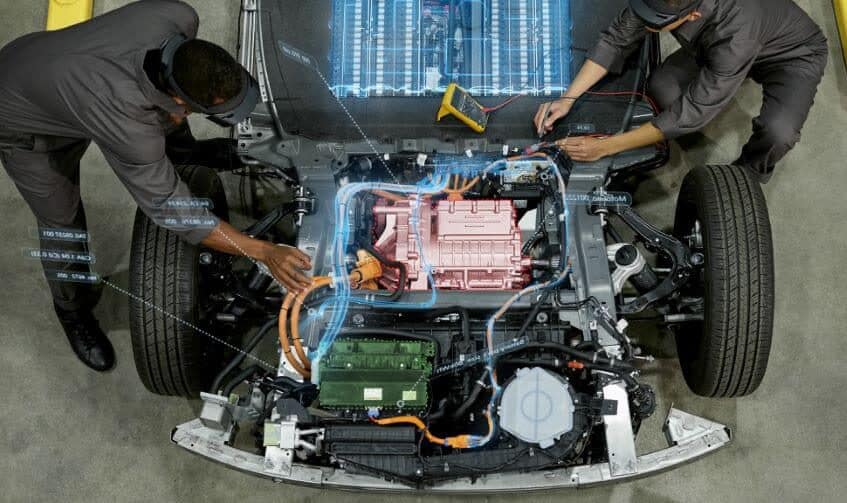
- training
At the moment, when you want to train people on very expensive machine tools or robots, you can only do it with one person at a time, because of the price of the machines. With metavers, you can train as many people as there are helmets available.
These simulations are already used in the industrial sector and in high-risk environments such as the nuclear and chemical industries. A person could pilot an industrial robot or a crane, or drive a train to its destination without leaving their armchair. Of course, these simulations already exist, but the metaverse adds an extra dimension because it abolishes borders. What's more, all the exchanges and what we do in the metaverse are recorded and logged for future use, which is very useful for skills management.
- architecture
Architecture is naturally very fond of 3D modelling. Architects can now present their models by showing them directly to their customers. They will also be able to contribute to the booming virtual property market. Investors are already spending millions on NFTs - unique digital property ownership certificates - to buy virtual properties. With the metaverse, architects become content creators.
What's more, the creators of metavers play on the scarcity phenomenon by limiting the size of the plots of land and properties for sale. The prospects for development are excellent: according to the World Trade Organisation (WTO), the market for digital goods is growing twice as fast as the market for physical goods.
For example, the French company Iconem has entered into a partnership with Microsoft. These engineers and architects intervene in war-torn countries with their Lidar and other 3D cameras to digitise historic monuments before they are destroyed. They then help local people to rebuild them. They are experts in digital twins, digital copies of real objects. The cathedral of Notre-Dame in Paris is being rebuilt in part thanks to Ubisoft, which digitised every square centimetre of its façade and interior for its Assassin's Creed video game.
- the industry
In the wake of theindustry 4.0The sector is obviously a stakeholder in the metaverse. Boeing is in the process of creating its own virtual universe based on digital twins of its aircraft. In this way, the American manufacturer is seeking to avoid design errors, but also to fine-tune its aircraft inspection and maintenance operations.
Germany's Siemens has joined forces with Nvidia to create an industrial metaverse. Their aim? To increase the use of digital twin technology driven by artificial intelligence to take industrial productivity and automation to the next level.
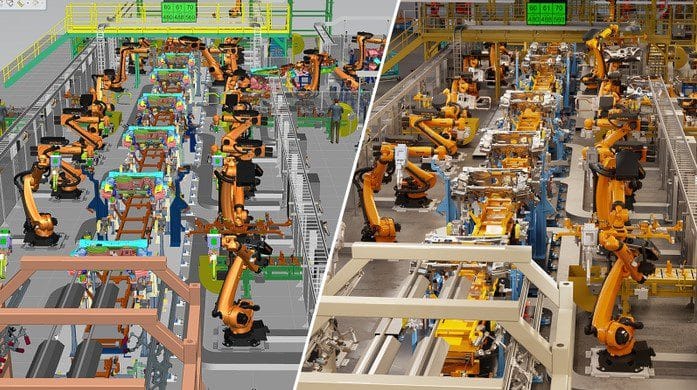
- the army
Let's not forget that we have the Internet thanks to the American army. The military have been using virtual reality and augmented reality for a long time. And they want to create their own metaverse to unify all their simulations, as well as signing contracts validated in the blockchain to ensure that the contract has not been modified.
Germany's ThyssenKrupp has signed an agreement with Airbus and the French army. ThyssenKrupp estimated that they could achieve productivity gains of up to 500 % by using virtual/augmented reality. One small caveat: it's complicated to wear a VR headset all day long, so these figures should be treated with caution.
- real estate and tourism
As mentioned above, land, houses and flats are already being sold in the metaverse. More and more estate agents are also offering virtual visits, with or without a headset, from a telephone or computer.
Virtual tours are also of interest to museums. The Google Art Project makes it possible to visit museums around the world, such as Versailles, in virtual reality. In the metaverse, we can imagine visiting these museums with other people, friends, a guide... with the possibility of adding our own comments and paying for admission with bitcoins or another cryptocurrency.
- meetings
In a meeting in the metaverse, you will no longer be limited by the size of the whiteboard. It will be possible to bring together people from all over the world in the same place, as with Zoom or Teams. It's justone more way to take part in a meeting. Some people will connect to a meeting from the metaverse, while others will connect more conventionally from their phone or computer. Microsoft has deployed its enterprise metaverse called Mesh for Teams.
In terms of equipment, companies will have to buy headsets. This cost is in addition to the cost of the computer. And some companies will dedicate a room for their employees to wear VR/RM headsets.
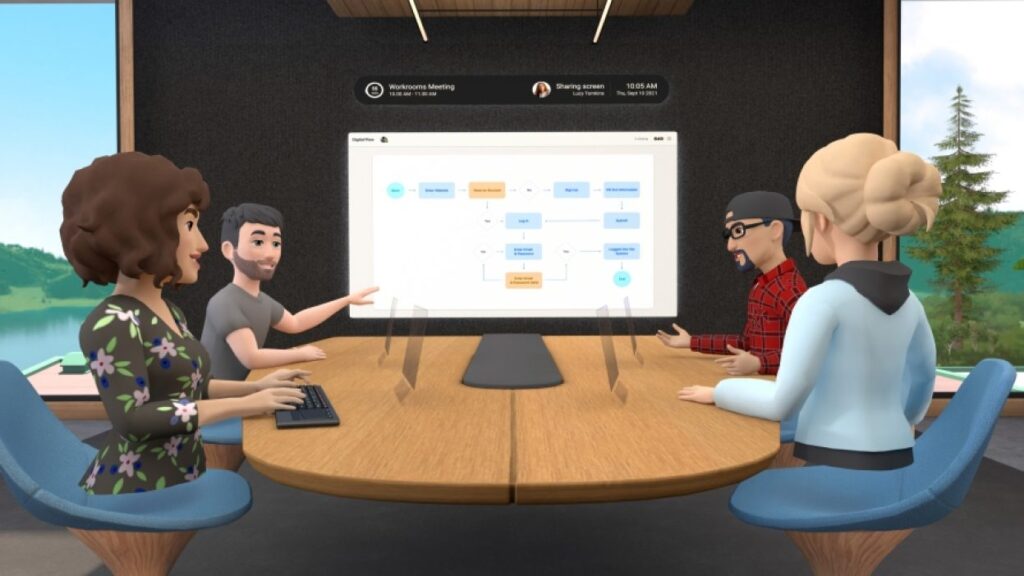
- human resources
Let's take the example of a candidate applying for a job as a machine tool operator. In the metaverse, he goes through his job interview and personality tests, and when he opens a virtual door, he arrives directly at the machine tool on which he will be put to the test.
Carrefour, for example, already conducts interviews in the metaverse to recruit IT specialists.
Virtual universes can also be used to organise training courses and improve team cohesion.team. For example, the game "Keep Talking and Nobody Explodes" encourages team building: a team has to defuse a bomb. Only one player is equipped with a VR headset to defuse the bomb using accessories. The other players, without headsets, have paper instructions on how to defuse the bomb. They must be able to communicate effectively with the player wearing the VR headset to solve the team problem.
In the future, we can imagine that one day we will be able to sign our employment contract in the metaverse and receive our pay by securing it via a blockchain.
- business
Commerce is the current driving force behind the metaverse. Purchases are made not only for real goods, but also for virtual goods. Metaverse users will spend money to change their appearance and personalise their avatar, just like in a video game. This involves buying clothes, accessories and so on. Thanks to NFTs, the objects will be guaranteed to be unique. Well-known brands such as Ralph Lauren, Zara and Walmart have announced the creation of virtual shops where customers can try on clothes before continuing their purchases online or in the physical world. This enables brands to test new products at low cost, get to know their customers better and target them more effectively for future campaigns.
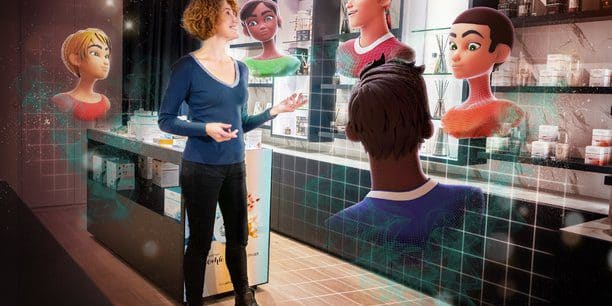
How does the metaverse work?
This virtual space uses servers distributed around the world. The metaverse, by definition, must be an overlay of the real world. It therefore requires an infrastructure that provides the fastest possible access, as close as possible to the users. And we won't need to be dependent on a fibre optic connection to access it: 5G will provide mobile access.
What's more, these servers need to be powerful enough to store the maps, environments and 3D objects in the virtual world. Being persistent, this world must be able to be logged, recording everything that has been done when an object is added, moved or deleted. We know who did what and when. This generates a phenomenal amount of data. Why log? For example, to be able to go back if a user degrades the universe.
How do you get there?
Mainly VR headsets. They are improving over time. With the first models, you couldn't move your head very much. Today's solutions are lighter and lighter, stand-alone (no need to connect them to a computer) with a huge number of degrees of freedom for the user. The latest versions cost around €500.
The next step is mixed reality headsets, which are very expensive for the general public. Meta and Microsoft, with HoloLens, have developed solutions that will take over the market. Mixed reality adds interaction with the real world. For example, if you lift the bonnet of a car that has broken down, you can see the problem and how to fix it, even if you know nothing about mechanics. This type of interaction is very much in demand in the industrial world.
The metaverse is multimodal, and can also be accessed via connected glasses (Ray-Ban has signed a contract with Meta), screen booths that allow you to do without headphones, a computer, a tablet, a phone or a television. But headsets are set to take over, as they are far more immersive.
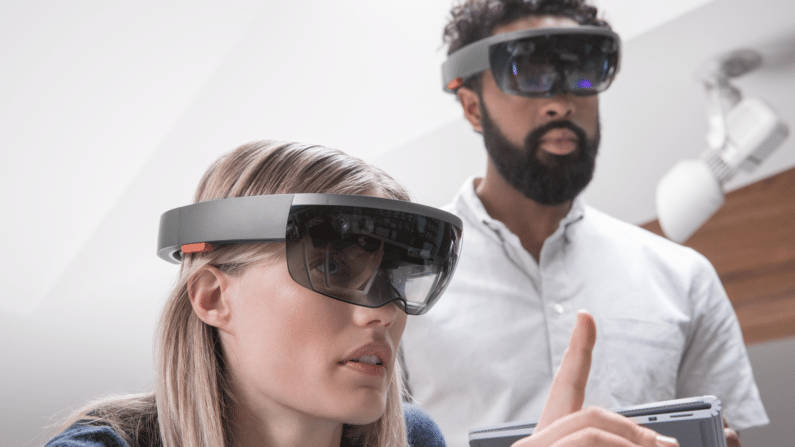
Who are the players in the metaverse?
Of course, the infrastructure and equipment needed for metavers require heavy investment. Only companies on a global scale are capable of implementing them. Among the players are major network companies, but also the Gafams: Facebook, as we have seen, Microsoft with its HoloLens headset and its Mesh for Microsoft Teams metaverse for meetings, and Microsoft Mesh for creating virtual worlds; Amazon, Apple and Google are also said to have projects in the pipeline.
To date, however, it is the video game industry that has mastered the most advanced 3D engines. One example is Nvidia, which offers graphics cards and its own language for creating virtual universes, USD (Universal Scene Description), which is intended to be the future HTML for metaverses.
As far as video game studios are concerned, the famous Roblox platform has more than 50 million active users every day who use its exclusive game engine, Roblox Studio, to create, share, buy and sell games within its online community.
Today, we shouldn't say metavers, but metavers. These are currently different sites with separate accesses. There is no gateway and nothing unified. It's a bit like the early days of the Internet, with several access providers, several search engines...
Metavers, a future still in the making
Metavers are the subject of speculation. Companies are investing without any certainty of a return on their investment. Not to mention the fact that the word metaverse is overused to sell robots, connected objects, software, etc. Yet this new virtual space has real potential for businesses, whether for recruiting, selling products and services or training employees.
Investing in the metaverse means investing in the new technologies that make it up, such as 3D, virtual reality, blockchain, 5G, IoT, artificial intelligence, etc. For a company, it is also a breeding ground for extraordinary talent that is rare on the market. These same engineers can work in other fields such as medicine, industry, etc.
Investing in metavers means discovering new things that could be patented and have a completely different use than metavers, with a very significant economic impact. According to Gartner, the metaverse will represent a potential market of 800 billion dollars by 2024. It would be a shame to miss out.
GUIDED TOUR OF METAVERS
Experiments accessible directly from your browser:
- (web) Decentralanda virtual world you can use from your browser, powered by the Etherum blockchain.
https://play.decentraland.org/ - (web) Do we really need 3 dimensions in the future of the metaverse? The answer with Gather :
https://www.gather.town/ - (web) Create your own online world with this "lite" version of Minecraft directly included in your browser:
https://classic.minecraft.net/ - (web) WebXR, a web technology that makes the virtual and the metaverse accessible via a simple browser:
https://mixedreality.mozilla.org/hello-webxr/ - (web) OpenSea NFT: collection of NFTs, the "illustrations" attached to a blockchain:
https://opensea.io/explore-collections - (web) After your avatar, customise your 'virtual' car:
https://carvisualizer.plus360degrees.com/threejs/
With a VR headset or an application, discover :
- (Meta Quest 2) Meta Horizon Workrooms The future of metavers according to Meta/Facebook :
https://www.oculus.com/workrooms/ - (HoloLens 2) MeshMicrosoft's vision of the metaverse:
https://docs.microsoft.com/fr-fr/mesh/overview - (Win/Mac App) SandboxThe virtual world, where plots of land are highly sought-after.
https://www.sandbox.game/


